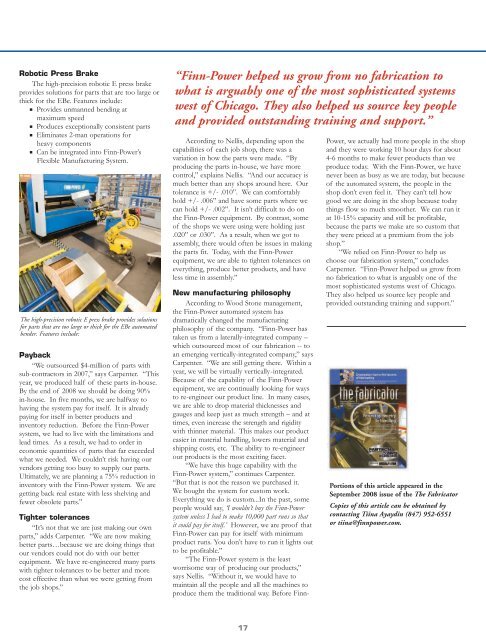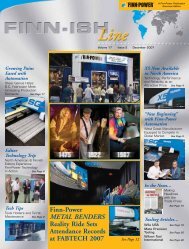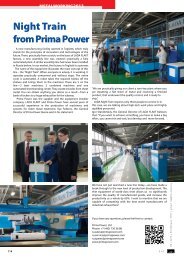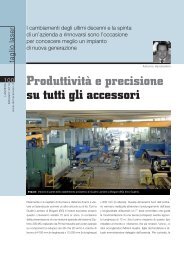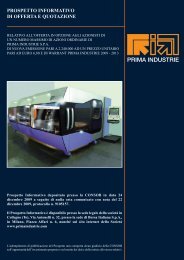Download PDF - Prima Power
Download PDF - Prima Power
Download PDF - Prima Power
- No tags were found...
You also want an ePaper? Increase the reach of your titles
YUMPU automatically turns print PDFs into web optimized ePapers that Google loves.
Robotic Press BrakeThe high-precision robotic E press brakeprovides solutions for parts that are too large orthick for the EBe. Features include:■ Provides unmanned bending atmaximum speed■ Produces exceptionally consistent parts■ Eliminates 2-man operations forheavy components■ Can be integrated into Finn-<strong>Power</strong>’sFlexible Manufacturing System.The high-precision robotic E press brake provides solutionsfor parts that are too large or thick for the EBe automatedbender. Features include:Payback“We outsourced $4-million of parts withsub-contractors in 2007,” says Carpenter. “Thisyear, we produced half of these parts in-house.By the end of 2008 we should be doing 90%in-house. In five months, we are halfway tohaving the system pay for itself. It is alreadypaying for itself in better products andinventory reduction. Before the Finn-<strong>Power</strong>system, we had to live with the limitations andlead times. As a result, we had to order ineconomic quantities of parts that far exceededwhat we needed. We couldn’t risk having ourvendors getting too busy to supply our parts.Ultimately, we are planning a 75% reduction ininventory with the Finn-<strong>Power</strong> system. We aregetting back real estate with less shelving andfewer obsolete parts.”Tighter tolerances“It’s not that we are just making our ownparts,” adds Carpenter. “We are now makingbetter parts…because we are doing things thatour vendors could not do with our betterequipment. We have re-engineered many partswith tighter tolerances to be better and morecost effective than what we were getting fromthe job shops.”“Finn-<strong>Power</strong> helped us grow from no fabrication towhat is arguably one of the most sophisticated systemswest of Chicago. They also helped us source key peopleand provided outstanding training and support.”According to Nellis, depending upon thecapabilities of each job shop, there was avariation in how the parts were made. “Byproducing the parts in-house, we have morecontrol,” explains Nellis. “And our accuracy ismuch better than any shops around here. Ourtolerance is +/- .010”. We can comfortablyhold +/- .006” and have some parts where wecan hold +/- .002”. It isn’t difficult to do onthe Finn-<strong>Power</strong> equipment. By contrast, someof the shops we were using were holding just.020” or .030”. As a result, when we got toassembly, there would often be issues in makingthe parts fit. Today, with the Finn-<strong>Power</strong>equipment, we are able to tighten tolerances oneverything, produce better products, and haveless time in assembly.”New manufacturing philosophyAccording to Wood Stone management,the Finn-<strong>Power</strong> automated system hasdramatically changed the manufacturingphilosophy of the company. “Finn-<strong>Power</strong> hastaken us from a laterally-integrated company –which outsourced most of our fabrication -- toan emerging vertically-integrated company,” saysCarpenter. “We are still getting there. Within ayear, we will be virtually vertically-integrated.Because of the capability of the Finn-<strong>Power</strong>equipment, we are continually looking for waysto re-engineer our product line. In many cases,we are able to drop material thicknesses andgauges and keep just as much strength – and attimes, even increase the strength and rigiditywith thinner material. This makes our producteasier in material handling, lowers material andshipping costs, etc. The ability to re-engineerour products is the most exciting facet.“We have this huge capability with theFinn-<strong>Power</strong> system,” continues Carpenter.“But that is not the reason we purchased it.We bought the system for custom work.Everything we do is custom...In the past, somepeople would say, ‘I wouldn’t buy the Finn-<strong>Power</strong>system unless I had to make 10,000 part runs so thatit could pay for itself.’ However, we are proof thatFinn-<strong>Power</strong> can pay for itself with minimumproduct runs. You don’t have to run it lights outto be profitable.”“The Finn-<strong>Power</strong> system is the leastworrisome way of producing our products,”says Nellis. “Without it, we would have tomaintain all the people and all the machines toproduce them the traditional way. Before Finn-<strong>Power</strong>, we actually had more people in the shopand they were working 10 hour days for about4-6 months to make fewer products than weproduce today. With the Finn-<strong>Power</strong>, we havenever been as busy as we are today, but becauseof the automated system, the people in theshop don’t even feel it. They can’t tell howgood we are doing in the shop because todaythings flow so much smoother. We can run itat 10-15% capacity and still be profitable,because the parts we make are so custom thatthey were priced at a premium from the jobshop.”“We relied on Finn-<strong>Power</strong> to help uschoose our fabrication system,” concludesCarpenter. “Finn-<strong>Power</strong> helped us grow fromno fabrication to what is arguably one of themost sophisticated systems west of Chicago.They also helped us source key people andprovided outstanding training and support.”Portions of this article appeared in theSeptember 2008 issue of the The FabricatorCopies of this article can be obtained bycontacting Tiina Ayaydin (847) 952-6551or tiina@finnpower.com.17


